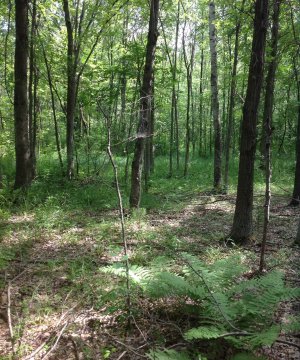Wet Loamy or Clayey Lowland
Scenario model
Current ecosystem state
Select a state
Management practices/drivers
Select a transition or restoration pathway
-
Transition T1A
Stand replacing disturbance that includes fire.
More details -
Transition T1B
Removal of forest cover and tilling for agricultural crop production.
More details -
Restoration pathway R2
Deciduous forest community is slowly taken over by shade tolerant maples and other species.
More details -
Transition T2A
Removal of forest cover and tilling for agricultural crop production.
More details -
Restoration pathway R3A
Cessation of agricultural practices leads to natural reforestation, or site is replanted.
More details -
Restoration pathway R3B
Cessation of agricultural practices leads to natural reforestation, or site is replanted.
More details -
No transition or restoration pathway between the selected states has been described
Target ecosystem state
Select a state
Description
Reference state is a forest community dominated by Sugar and red maple (Acer saccharum and Acer rubrum) with White ash (Fraxinus americana), Basswood (Tilia americana), and Red and White oak (Quercus rubra and Quercus alba). Depending on history of disturbance, two community phases can be distinguished largely by differences in dominance of tree species and community age structure.
Submodel
Description
Pure, or mixed, aspen – paper birch community replaces the reference state community. If seed source is present, red maple and young cohorts of balsam fir readily becomes member of this community.
Submodel
Mechanism
Stand replacing disturbance that must include fire to create conditions for aspen and paper birch to colonize the site.
Mechanism
Removal of forest cover by whatever means, followed by tilling for agricultural crop production. Establishment of agricultural crops, hay, or pasture following the disturbance.
Mechanism
Deciduous forest community slowly ages out and is invaded by shade tolerant species.
Mechanism
Removal of forest cover by whatever means, followed by tilling for agricultural crop production. Establishment of agricultural crops, hay, or pasture following the disturbance.
Mechanism
Cessation of agricultural practices leads to natural reforestation, or site is replanted. Initial species is seed source dependent unless planted. Most likely initial species are Aspen and Red Maple.
Model keys
Briefcase
Add ecological sites and Major Land Resource Areas to your briefcase by clicking on the briefcase (![]() ) icon wherever it occurs. Drag and drop items to reorder. Cookies are used to store briefcase items between browsing sessions. Because of this, the number of items that can be added to your briefcase is limited, and briefcase items added on one device and browser cannot be accessed from another device or browser. Users who do not wish to place cookies on their devices should not use the briefcase tool. Briefcase cookies serve no other purpose than described here and are deleted whenever browsing history is cleared.
) icon wherever it occurs. Drag and drop items to reorder. Cookies are used to store briefcase items between browsing sessions. Because of this, the number of items that can be added to your briefcase is limited, and briefcase items added on one device and browser cannot be accessed from another device or browser. Users who do not wish to place cookies on their devices should not use the briefcase tool. Briefcase cookies serve no other purpose than described here and are deleted whenever browsing history is cleared.
Ecological sites
Major Land Resource Areas
The Ecosystem Dynamics Interpretive Tool is an information system framework developed by the USDA-ARS Jornada Experimental Range, USDA Natural Resources Conservation Service, and New Mexico State University.

